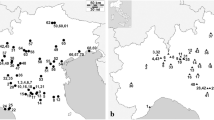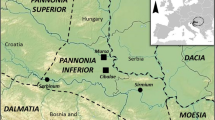Abstract
New investigations of two archaeobotanical finds are presented: a large assemblage of pure fruits of Polygonum lapathifolium from Bremen-Strom, Germany and the gut contents of a bog body from Kayhausen near Oldenburg, Germany. The general question is to find out for sure which herb species were intentionally gathered for human consumption. To accept species as such, they have to fulfil mainly two criteria: they must occur in large and pure assemblages, separated from other species, and they should occur regularly in the stomach or gut of dead bodies. To ensure this, the data from all bog bodies whose intestines have been examined were compiled and in addition to this, fossil assemblages of the species in question were put together. It turned out that apart from gathering in the wild, the collection of seeds and fruits from weeds in the process of crop cleaning was a major source of their edible diaspores. Obviously some common weeds, obtained in this way, were welcome as an addition to human diet and received the status of secondary cultivated plants. The following six species are regarded as having surely been deliberately collected and used in human diet: Polygonum lapathifolium, Chenopodium album, Spergula arvensis, Fallopia convolvulus, Bromus secalinus and Glyceria fluitans. Another two, Setaria sp. and Rumex acetosella probably complete this list.



Similar content being viewed by others
References
Behre K-E (1986) Kulturpflanzen und Unkräuter des Mittelalters—Funde aus der Kirche von Horsten/Ostfriesland. Abhandl Westfäl Mus Nat 48:441–456
Behre K-E (1991) Die ersten Funde von Nahrungspflanzen aus dem Mittelalter Bremens. Bremisches Jahrb 70:207–227
Behre K-E (1992) The history of rye cultivation in Europe. Veget Hist Archaeobot 1:141–156
Behre K-E (1999) Die letzte Mahlzeit des ‘Jungen von Kayhausen’: Eine Untersuchung der Speisereste aus dem Darmtrakt. Schriftenr Staatl Mus Naturk Vorgesch Oldenburg 1, Beiheft 10:76–78
Behre K-E, Kučan D (1994) Die Geschichte der Kulturlandschaft und des Ackerbaus in der Siedlungskammer Flögeln, Niedersachsen, seit der Jungsteinzeit. Probl Küstenforsch südl Nordseegebiet 21, Isensee, Oldenburg
Brinkkemper O (1993) Wetland farming in the area to the south of the Meuse estuary during the Iron Age and Roman Period. Analecta Prehistorica Leidensia 24
Brinkkemper O (2007) Study of the preservation quality of archaeological sites using botanical macro-remains. Berichten van de Rijksdienst voor het Oudheidkundig Bodemonderzoek 46:303–314
Dembinska M (1976) Wild corn plants gathered in the 9th–13th centuries in the light of paleobotanical materials. Folia Quaternaria 47:97–103
Dieck A (1975) Darmuntersuchungen bei europäischen Moorleichen. In: Festschrift Schneider: Moor und Torf in Wissenschaft und Wirtschaft. Bad Zwischenahn, pp 33–42
Dobrochotov WN (1961) Samen der Unkrautpflanzen (in Russian). Moscow
Groenman-van Waateringe W, Pals JP (1983) The Assendelver polders project: integrated ecological research. BAR Int Ser 181:135–161
Grohne E (1934) Bericht über die Ausgrabung der Hove-Warf im Niedervieland bei Bremen. Abhandl Vortr Bremer Wiss Ges 8/9:1–14
Hatt G (1943) Jydsk Bondeliv i ældre Jernalder [Jutish farmers’ life in the older Iron Age]. Globus, Copenhagen
Hatt G (1957) Nørre Fjand, an early Iron Age village site in West Jutland. Arkaeolog Kunsthist Skr Dansk Vidensk Selskab SA 2:2 København
Hayen H (1964) Die Knabenmoorleiche aus dem Kayhausener Moor 1922. Oldenburger Jb 63:19–42
Hegi G (1935) Illustrierte Flora von Mitteleuropa 1, 2nd edn. München
Helbæk H (1951a) Tollundmandens sidste Maaltid. [Botanical studies of the stomach contents of the Tollund Man, in Danish with English summary]. Aarböger Nordisk Oldkyndighed Historie 1950:311–341
Helbæk H (1951b) Ukrudtsfrö som naeringsmiddel [Seeds of weeds in the fore-Roman Iron Age, in Danish with English summary]. Kuml 1951:65–74
Helbæk H (1954) Prehistoric food plants and weeds in Denmark. Danmarks Geologiske Undersögelse II. Række 80:250–261
Helbæk H (1959) Grauballemandens sidste Maaltid [The last Meal of Grauballe Man]. Kuml 1958:83–116
Helbæk H (1960) Comment on Chenopodium album as a food plant in prehistory. Ber Geobot Inst Rübel Zürich 31:16–19
Hillman G (1984) Interpretation of archaeological plant remains: the application of ethnographic models from Turkey. In: van Zeist W, Casparie WA (eds) Plants and ancient man. Balkema, Rotterdam, pp 1–41
Hjelmqvist H (1955) Die älteste Geschichte der Kulturpflanzen in Schweden. Opera Botanica 1:3, Almqvist & Wiksell, Stockholm
Holden TG (1995) The last meals of the Lindow bog men. In: Turner RC, Scaife RG (eds) Bog bodies. British Museum Press, London, pp 76–82
Holden TG (1999) Food remains from the gut of the Huldremose bog body. J Danish Archaeol 13:49–55
Jacomet S, Brombacher C, Dick M (1989) Archäobotanik am Zürichsee. Ber Zürcher Denkmalpflege, Monographien 7, Orell Füssli, Zürich
Jessen K (1933) Planterester fra den ældre Jernalder i Thy. [Pflanzenreste aus der älteren Eisenzeit in Thy (Jylland)]. Botanisk Tidsskift 42:257–288
Jones GEM (1984) Interpretation of archaeological plant remains: ethnographic models from Greece. In: van Zeist W, Casparie WA (eds) Plants and ancient man. Balkema, Rotterdam, pp 43–61
Knörzer K-H (1967a) Subfossile Pflanzenreste von bandkeramischen Fundstellen im Rheinland. Archaeo-Physika 2:3–29
Knörzer K-H (1967b) Die Roggentrespe (Bromus secalinus L.) als prähistorische Nutzpflanze. ArchaeoPhysika 2:30–38
Knörzer K-H (1971) Genutzte Wildpflanzen in vorgeschichtlicher Zeit. Bonner Jahrbücher 171:1–8
Kohl JG (1864) Nordwestdeutsche Skizzen 1. Schünemann, Bremen
Kreuz A (2007) Archaeobotanical perspectives on the beginning of agriculture north of the Alps. In: Colledge S, Conolly J (eds) The origins and spread of domestic plants in southwest Asia and Europe. Left Coast Press, California (in press)
Kroll H (1990) Melde von Feudvar, Vojvodina. Praehistorische Zeitschrift 65:46–48
Kučan D (1979) Mittelalterliche Kulturpflanzen und Unkräuter aus ostfriesischen Kirchen. Probl Küstenforsch südl Nordseegebiet 13:23–38
Martin O (1967) Bericht über die Untersuchung der Speisereste in der Moorleiche von Dätgen. Offa 24:77–78
Mohr R (1990) Untersuchungen zur nacheiszeitlichen Moor- und Vegetationsentwicklung im nordwestlichen Niedersachsen mit besonderer Berücksichtigung von Myrica gale. Vechtaer Arbeiten zur Geographie und Regionalwissenschaft 12
Neuweiler E (1905) Die prähistorischen Pflanzenreste Mitteleuropas. Vierteljahrsschr Naturforsch Ges Zürich 50:1–111
Nitz H-J, Riemer P (1987) Die hochmittelalterliche Hufenkolonisation in den Bruchgebieten Oberstedingens (Wesermarsch). Oldenburger Jb 87:1–34
O’Connell M (1986) Pollenanalytische Untersuchungen zur Vegetations- und Siedlungsgeschichte aus dem Lengener Moor, Friesland (Niedersachsen). Probl Küstenforsch südl Nordseegebiet 26:171–193
Pieper P, Behre K-E, Möhlenhoff P, Parpatt PM, Schübel F, Schübel J (1999) Moor-Leichen. Schriftenr Staatl Mus Naturk Vorgesch Oldenburg 1, Beiheft 10:63–79
Renfrew JM (1973) Palaeoethnobotany. The prehistoric food plants of the Near East and Europe. Methuen, London
Van der Sanden W (1995) Bog bodies on the continent: developments since 1965, with special reference to the Netherlands. In: Turner RC, Scaife RG (eds) Bog bodies. British Museum Press, London, pp 146–165
Van der Sanden W (1996) Mumien aus dem Moor. Die vor- und frühgeschichtlichen Moorleichen aus Nordwesteuropa. Batavian Lion, Amsterdam
Van Zeist W (1970) Prehistoric and early historic food plants in the Netherlands. Palaeohistoria 14:41–173
Van Zeist W, Boekschoten-van Helsdingen AM (1991) Samen und Früchte aus Niederwil. In: Waterbolk HT, van Zeist W (eds) Niederwil, eine Siedlung der Pfyner Kultur. Haupt, Bern, pp 49–113
Willerding U (1986) Zur Geschichte der Unkräuter Mitteleuropas. Göttinger Schr Vor- Frühgesch 22, Wachholtz, Neumünster
Acknowledgments
I wish to thank Prof. Dr M. Frechen, Hannover, who provided the 14C dates, M. Spohr for preparing the map and D. Kučan and T. Reiser for taking the photographs. This contribution is dedicated to Prof. Dr Corrie Bakels on the occasion of her 65th birthday with cordial thanks for long-lasting and fruitful cooperation.
Author information
Authors and Affiliations
Corresponding author
Rights and permissions
About this article
Cite this article
Behre, KE. Collected seeds and fruits from herbs as prehistoric food. Veget Hist Archaeobot 17, 65–73 (2008). https://doi.org/10.1007/s00334-007-0106-x
Received:
Accepted:
Published:
Issue Date:
DOI: https://doi.org/10.1007/s00334-007-0106-x




